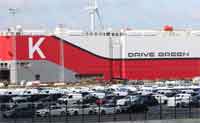| |
|
| |
|
 |
Supply
Chain by the Numbers |
| |
|
| |
- April 28, 2022
|
| |
|
| |
|
| |
|
| |
Walmart Drivers Make a Nice Living; Low Value Chinese Exports to US under Scrutiny; Cooking Oil Prices Soaring, Sparking more Inflation; Luxury Cars Headed for Russia Stuck at Port |
| |
|
| |
| |
| |
| |
21 |
|
That is how many paid vacation days a truck driver for Walmart can now have in their first year on the job. That according to Fernando Cortes, senior vice president of Walmart Transportation, in an interview with Transport Topics magazine this week. That’s on top of the big boost in pay for drivers Walmart announced a few weeks ago, with some now able to earn $110,000 in year one. Cortes used the interview to tout other elements of Walmart’s program for its private fleet drivers. That also includes improved schedules that give drivers more time at home. The changes mean regional drivers can be home more often, for a minimum of two nights per week and up to three nights in a row. The retailer also added new local driving jobs in select areas that allow drivers to be home after every shift. Cortes said drivers get access to company benefits on their first day, and receive benefits like medical coverage, a 401(k) with a 6% company match, an associate stock purchase plan and a paid for college education. |
|
|
| |
| |
|
|

Photo: Dursun Aydemir |
| |
| |
| |
|
That incredibly is the approximate number of luxury cars sitting at Belgium’s Port of Zeebrugge, stranded because they were headed to Russia. The cars, which include the latest Lexus, Cadillac and Mercedes models, arrived from Asia in early April. But now the vehicles come under a ban against luxury goods exports to Russia as part of the sanctions stemming from the Ukraine invasion. In fact, there is a whole range of products stuck at Zeebrugge because of sanctions. The European Union has issued guidelines on the bans but port operators say the rules are often confusing and involve a lot of exemptions. European customs officers are struggling to keep up, contributing to – what else – more supply chain disruptions. |
|
| |
| |
10+% |
 |
That’s the percent of Chinese imports by value now arrive as “de minimis” shipments, according customs data and as reported this week by the Wall Street Journal. That’s up from less than 1% a decade ago. What are de minimis imports? They started under federal law to allow American tourists to bring back souvenirs from overseas duty-free. Now de minimis imports have soared to over $67 billion in 2020 from an estimated $40 million in 2012. What is going on? Two things: ecommerce orders shipped from off shore; and exporters getting around US tariffs by shipping many smaller orders, worth below di minimis thresholds. And that’s now easier, after a 2016 decision by Congress to raise the maximum value of de minimis imports to $800, up from $200 previously. In fact, the law allows US retailers that sell Chinese imports - along with Chinese companies that sell directly to US consumers - to avoid tariffs on goods as long as they are packaged and addressed to individual buyers and fall below the $800 cap. Many are calling for changes in the rules. |
| |
| |
| |
| |
| |
|
|
|
| |
 |
 |
| |
 |
![]() |
 |
|
| |
 |
Feedback |
|
|
|
![]()
|
No Feedback on this article yet.
|
|
![]() |
|
|
|
![]() |
 |
![]() |
 |
|
| |